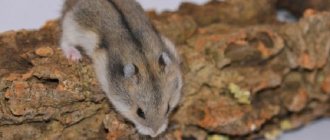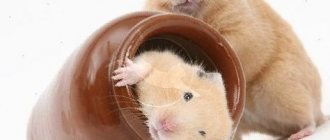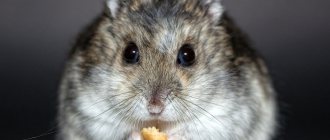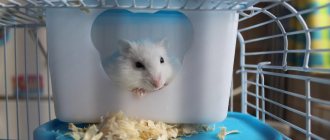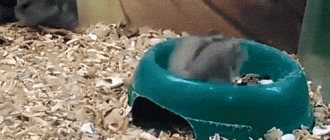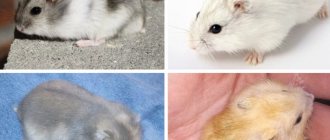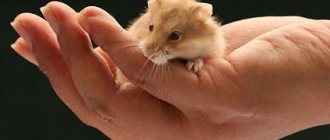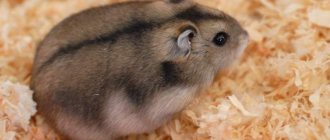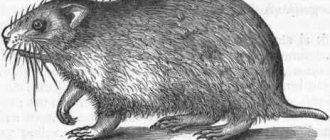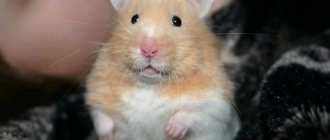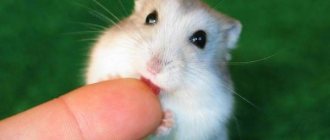Breeds of domestic hamsters
Animals of the rodent order of the hamster family come in different colors and sizes.
There are shaggy and smooth-haired varieties. The most suitable breeds for home keeping include the following breeds:
- Dzungarian.
- Angora.
- Syrian.
- Campbell.
- Roborovskaya.
These rodents have a gentle character and quickly get used to humans. They are unpretentious, so they can be cared for by a child over 7 years old.
Dzungarian
The Dzungarian breed is most suitable for home keeping. Its other name is Sungur hamster. The length of a purebred rodent is 6-10 centimeters. The weight of the animal rarely exceeds 65 g. The classic color of the back is dark gray or brown, and the belly is beige.
Representatives of the breed can be recognized by the dark stripe running along the spine and turning into a diamond on the head. The nose is pink, the ears are round, the fingers are covered with sparse white hairs.
The following decorative subspecies have been bred, differing in fur color: sapphire, lilac, pearl, marble and tangerine.
A pair brings 2-4 litters per year. On average, each of them has up to 8 kids. The size of newborns does not exceed 1 cm, but they grow quickly and become sexually mature at 6 months. Only individuals of different sexes get along well with each other. In addition, animals are predisposed to diabetes.
According to the classification, the Russian dwarf hamster belongs to the Djungarian hamster. It is more difficult for him to make contact with a person, but with regular communication he can be tamed.
Syrian
The Syrian hamster is a medium-sized rodent, whose body length is 12 cm and weight is 100-140 g. Some individuals reach 20 cm. Their natural color is golden. Varieties with silver, pearl, red and beige fur were selectively bred.
According to the structure of the wool, “Syrians” are:
- long-haired;
- short-haired;
- curly;
- satin;
- hairless.
Animals are in good health. On average they live up to 4 years.
Syrian hamsters have good health and live on average up to 4 years.
Angora
The Angora hamster is not a separate species. This is the name of the fluffy long-haired representatives of the Syrian breed. Animals grow up to 12 cm and reach a weight of 200 g. The length of the coat in males is 6 cm, and in females - 2 cm.
Their thick fur makes them appear larger. Their color can be cream, black, gray, white, sand, tortoiseshell, ash, etc.
Rodents require special care and regular brushing. However, they cannot be washed: the animals have weak immunity and are susceptible to colds. When favorable conditions are created, the Angora hamster lives in captivity for up to 3-4 years.
Roborovsky's hamster
This is a mini rodent, reaching 5 cm in length. The weight of the animal does not exceed 30 g. It has a large head and an elongated, slightly flattened muzzle. There are light tufts of fur above the black eyes. The fur on the back is grey-beige, light brown or sandy. The abdomen is light. Less common are cream-colored individuals. Their fur is highly fluffy.
The rodent requires delicate handling, because... his bones are too thin and can break if pressed too hard. It is recommended to keep these animals in same-sex groups of 3-5 individuals.
Campbell's hamster
Externally, Campbella resembles the Dzungarian variety. These animals reach 15 cm in length. They have a spotted or golden skin color and a less pronounced transition to a lighter belly. Campbell's ears are small.
They give birth 2-3 times a year. Up to 5 cubs appear at a time. Rodents have poor eyesight but a good sense of smell. Campbell's life expectancy is 2 years.
The Campbell's hamster is similar in appearance to the Djungarian variety.
Fictional
Now there are many fictional breeds of rodents. This is due to the desire of owners to have rare and unusual pets. In addition, sellers often give unusual names to animals.
The following breeds are considered fictional:
- royal;
- albino;
- golden;
- white;
- black, etc.
Shaggy, orange or peach-colored “Syrians” are often passed off as “royal” rodents. Albinos are not a separate breed. Snow-white animals with red eyes are born with a genetic abnormality that prevents their bodies from producing pigment.
Albinos often have health problems. They have poor eyesight and hearing. Golden and black rodents in most cases belong to the Dzungarian or Syrian breed.
Features of black hamsters
Black color is quite rare in hamsters. A rodent is not considered black if its fur is unevenly colored , for example, there are white spots or specks on the abdomen. And only the white spots on the toes make it possible to determine the color of the hamster as black.
But apart from beautiful and bright dark fur, the black hamster is no different from its relatives: the physique, weight and size of hamsters are the same. Dark-colored rodents, like their comrades, are very clean, curious, active and playful.
How to care
A home for a black hamster can be an aquarium or a cage. You need to choose a spacious house for your pet, because hamsters actively move, scurry around and do not like to sit still. Such an apartment will resemble a mink.
If you have several pets, you can purchase a two-story cage. Moreover, hamsters love to climb everywhere. But you don’t need to make the cage too high so that the animal doesn’t get hurt if it suddenly breaks and falls. The best solution would be to purchase a metal cage to ensure that your pet will not escape from its hole.
The temperature in the room where the hamster lives should be comfortable - not lower than 20 degrees. You should not leave your pet in an open draft, because animals easily catch colds and get sick.
You need to feed the animal with pieces of vegetables and fruits, leaves of fresh herbs, and be sure to ensure that the pet has free access to clean drinking water in the drinking bowl. You can buy a drinking bowl in a store or make it yourself.
Breeds of wild hamsters
The unusual appearance of some wild species increases their value. However, keeping such animals has its own characteristics. Rodents are nocturnal and like to dig shelters for themselves, so they require more space than domestic breeds. In addition, you need to be prepared for the possible aggressive behavior of your pet.
Grey
The gray hamster looks like a small mouse. Its body length is 13 cm. The animal’s back is dark gray and its abdomen is lighter. The rodent's paws are hairy.
The animals have an elongated muzzle, black eyes and short ears. Their body ends with a short tail covered with sparse hair, which enhances the resemblance to a mouse. Animals do not reproduce well in captivity.
The gray hamster looks like a small mouse, with a body length of 13 cm.
Ordinary
Many pet hamsters sold in pet stores can be called “ordinary”. However, in the classification, this term is used for wild carbysh that live in steppe and forest-steppe zones. These are large rodents, whose length is 24 cm. The animals have beautiful red-brown fur. These are white-footed rodents with light beige spots on the face and sides. Karbysh are long-lived.
Pre-Caucasian
The Radde breed, which is also called Pre-Caucasian, lives in the foothills. Rodents settle near cereal fields. They have a striped color. Their back is gray, their belly is black, and their sides are beige. There is a light stripe on the ears. Animals grow up to 30 cm and weigh more than 700 g.
Radde has a developed instinct for stockpiling. In their pantry during the summer season they can prepare up to 16 kg of feed. Rodents are secretive and active at night.
Barabinsky
The body of the Barabinsky hamster reaches 8-12 cm. The animal has a small tail. The fur is light brown with rusty spots. Because of this color, the animal is often called yellow-bottomed. The rodent's feet are covered with thick fur, which protects the toes from freezing during the cold season.
It is not difficult to create favorable conditions for animals. Wood litter is used for bedding. In addition, several houses need to be installed in the cage. “Barabintsi” are undemanding when it comes to food, but they have a wild character and do not tolerate increased attention.
Daursky
The Daurian hamster is not a separate breed, but a variety of the Barabinsky. Features of the animal are the dark color of the back and a clear black stripe of fur running along the spine. The rodent's abdomen is gray.
Brandt's hamster
The Brandt is a medium-sized animal. Its body length is 15-18 cm. It has a short tail. The weight of the animal does not exceed 300 g. The back is brown, the belly is gray. There is a dark spot on the chest, light spots on the cheeks.
Brandt's hamster has a brown back and gray belly.
Eversmann's hamsters and Mongolian
Eversmann and Mongolian hamsters belong to the same genus. The length of the animals is on average 16 cm. “Mongolians” are slightly smaller and have lighter gray fur on the back. Rodents of both species have light beige hair on their paws and abdomen.
Hamster Sokolov
The length of Sokolov's hamster reaches 11.5 cm. His fur is gray-beige. These rodents stay away from people and do not harm crops in Mongolia and China. The type and characteristics of their diet have been poorly studied. In captivity, these animals do not live long.
Chinese
The Chinese species of hamster, belonging to the gray genus, lives in captivity for no more than 3 years. These animals reach 8-12 cm in length. Their back is covered with gray-brown fur with a dark stripe along the spine. The abdomen is light gray. Animals produce 4-6 offspring per year.
Newton's hamster
Newton's hamster is covered in gray-brown fur. Only on the head and chest the fur is black. The abdomen is lighter. The ears are small. He looks for food in nature with his eyes, because... His sense of smell is poorly developed.
Taylor's Hamster
This is a South American species that is found in the steppes and deserts of Arizona and Mexico. The length of its body reaches 8 cm. The color of the rodent is dark gray or brown. The abdomen is covered with light fur. In natural conditions, the animal occupies the burrows of other rodents or builds nests in rock crevices or between stones.
Taylor's hamster is a South American species that is found in the steppes and deserts of Arizona and Mexico.
Grasshopper
The grasshopper hamster is also called the scorpion hamster. The weight of an adult is 40-60 g. The animal is shaggy. It has a thick undercoat that protects the rodent's body from the night cold. It is difficult to maintain this species, because... he is predatory. The basis of its diet are small insects.
Siberian
"Sibiryak" molts 2 times a year, adapting to seasonal changes. In summer its skin is dark gray, and in winter it is white. The average length of its body is 10 cm. Weight does not exceed 50 g. These animals require a certain temperature regime when kept at home to stimulate molting.
Tibetan
Tibetan hamsters are a dwarf breed found in the mountainous regions of China. They live at an altitude of up to 4 thousand m above sea level. Their skin is gray, and their belly is covered with light gray fur. Tibetan rodents cannot be tamed.
Kansky
Caen hamsters reach 17 cm in length. Their body is covered with dense gray fur. There are areas of white on the cheeks, ears and abdomen. This species is poorly studied. Existing data on diet and habits are insufficient to create conditions that are similar to natural conditions in captivity.
Rat-like
This is a dangerous agricultural pest found in the steppe regions of China. Its body length is 25 cm. Its back is covered with gray-brown hair. The soles are covered with thick fur. These animals are aggressive, so keeping them at home is not recommended.
Long-tailed
The hamster grows up to 12 cm. The peculiarity of the animal is its pubescent tail, reaching 5 cm. The fur on the sides and back is gray with black undercoat. The abdomen is white. The muzzle has an elongated shape. Large, large ears with a white border are set high on the head.
The peculiarity of the long-tailed hamster is its pubescent tail, reaching 5 cm.
Short-tailed
The body length of the short-tailed hamster is 10 cm. It weighs no more than 40 g. The rodent is covered with thick gray fur with a slight yellow tint.
Other
Attempts are now being made to keep Bengal and Brazilian hamsters at home. However, they do not adapt well to life in captivity.
Campbell
Campbell's hamsters have long been considered a subspecies of the Djungarian hamster. They were later identified as a separate species in honor of the discoverer, Charles William Campbell. Body size from 7 to 10 cm, weight 40-60 g. Eyes black or red. The Campbell hamster has a rounder muzzle than the Djungarian hamster.
Life expectancy is on average 3 years. Standard color is sandy grey. The fur coat can also be cream or brown.
There is a gray stripe on the back, like a Djungarian hamster. Campbell's stripe is lighter, Djungarik's is darker and more distinct.
Like most hamsters, Campbell should not be kept in the same cage as his fellow hamsters. This species is quite difficult to tame compared to other species. Many individuals are quite aggressive even towards humans, often biting.
Additional questions and answers
There are some important questions to consider before purchasing a rodent. This will help you choose the right animal and provide it with good conditions.
What is the smallest breed of hamster
Roborovsky hamsters are the smallest breed suitable for home keeping. Among wild rodents, “Taylors” stand out for their compact size.
What is the largest breed of hamster
Among domestic breeds, Syrians are considered the largest. Karbysh is the largest wild rodent.
Who is better to get - a Djungarian or a Syrian hamster?
Both breeds have their advantages and disadvantages. Thus, “Syrians” are larger, have an easy-going disposition and quickly learn to respond to a nickname. However, they need a spacious cage. Djungarian hamsters do not require much space. Now many varieties of this breed have been bred, so it is easier to choose an animal with the desired decorative qualities. Syrian hamsters are easier to care for.
Diseases
The Syrian hamster is more resistant to disease than the black dwarf. Diseases in animals can be caused by various reasons. They can be associated with inflammatory processes in the gastrointestinal tract, skin, and respiratory organs. Genetic diseases cannot be excluded. But most often they are caused by bacteria and viruses.
To prevent your pet from contracting an infectious disease, you need to keep the cage clean. It is important to change the water on time and remove lost food. Dairy and meat foods included in a hamster's diet must be subjected to heat treatment.
Due to poor nutrition, metabolism can be disrupted. This especially affects jungarians, in whom a veterinarian can diagnose diabetes mellitus. The animals are very nimble and curious, they often fall and can damage their limbs.
Hamsters are gentle creatures. When they start to hurt, it can be recognized by the following symptoms:
- decreased appetite;
- weight dropped sharply;
- white discharge from the eyes;
- fur falls out intensively from the slightest touch;
- activity has decreased noticeably;
- The good-natured animal became aggressive.
If you have at least one of the symptoms, you should contact your veterinarian.
On a note. Hamsters have a sensitive nervous system. From stress, their hair may begin to fall out and their appetite may disappear. Cleaning the cage is done in the absence of the little owner. In the room where the hamster lives, you need to avoid loud noises.
Hamsters of any color are responsive to good care. Even those species of animals that cannot be tamed, with good care, will rejoice at the appearance of the owner. Black hamsters look impressive and are a pleasure to watch. To keep your pet healthy and active, you need to pay attention to it and follow simple care and maintenance conditions.
Source
Curious to know
Let's look at some interesting information about hamsters:
- There are many varieties of these rodents in the world. The largest sizes can weigh up to half a kilogram, while the smallest individuals weigh only 10 grams.
- Regardless of the species, all individuals have well-developed cheek pouches, in which they hide food in order to transfer it to their burrow.
- Some breeds can live in mountains at an altitude of up to 4 km.
- They tend to simply make huge reserves of food.
- Females independently raise their offspring; males do not take part in this.
- The diet is dominated by grains and plants, but it can also be food of animal origin.
- In the wild, they prefer to live in steppes and deserts.
- Many representatives of the species are good swimmers; for this they can inflate their cheeks, using them as floats, this allows them to stay on the water.
- These rodents cannot distinguish colors and have poor vision. At the same time, their senses such as smell and hearing are excellent.
- Their teeth do not stop growing throughout their lives, so it is very important to hang a mineral stone or put branches of fruit trees in the cage.
- These animals do not have a fear of heights, so keep this in mind and do not leave your pet unattended.
- Pregnancy lasts only 2-3 weeks depending on the species.
- The cubs are born with teeth.
- In most cases, rodents have no difficulty remembering nicknames.
Reference. The well-known Syrian hamster is listed in the Red Book, as it is on the verge of extinction.
Source
Roborovsky
This species is often called Robos. They are distinguished by their very small size, only 5 cm. The weight of the baby is 20-25 grams. Despite its small size, this hamster has a rather large head and a flattened muzzle. The ears are set high and round in shape.
The average life expectancy of a Roborovsky hamster is 3-4 years. This species is very shy and susceptible to stress, which significantly shortens their life.
Color: white, sand, grey. The muzzle is always white, regardless of the color of the coat.
They are rarely found at home. They are kept in special cages, since the distance between the bars of ordinary cages does not suit them.
Basic colors
The main colors of Syrian hamsters are presented:
Golden
This is the true color of hamsters, so it is the most common. It is similar to the color of mahogany. Therefore, it is also called the peach-colored Syrian hamster. In this case, the roots of the hairs are colored dark gray, and the tips are colored black. The belly is much lighter, colored ivory. The golden hamster has the characteristic features of gray ears and black eyes.
Black
This shade appeared at the turn of 1985-86. in France due to mutation. Due to its large size, in the USA this type of hamster is called the “Black Bear”.

